IB Biology HL (HIGHER level)- 2024 – Practice Questions- All Topics
Topic 6.6 Hormones, homeostasis and reproduction
Topic 6 Weightage : 20%
All Questions for Topic 6.6 – Insulin and Glucagon, Thyroxin, Leptin, Melatonin, Sexual Reproduction, Sex Development, Male Reproductive System, Female Reproductive System, Menstrual Cycle, In Vitro Fertilisation, Homeostasis, Feedback Loops, Endocrine System, Types of Hormones, Gender Issues, Menstrual Events
Question
The graph shows the blood levels of hormones associated with the menstrual cycle.
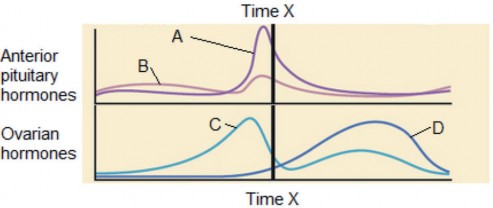
Which line on the graph represents progesterone?
A Line A
B Line B
C Line C
D Line D
▶️Answer/Explanation
Ans: D
Progesterone is an ovarian hormone. The Luteal phase of the Ovulation Cycle lasts approximately 14 days. In this phase, the dominant hormone of the Follicular Phase estrogen declines and progesterone levels increase. Progesterone levels fluctuate throughout your menstrual cycle. Levels rise after ovulation and continue to rise if pregnancy occurs. In the graph line D is representing Progesterone hormone levels.
The graph shows changes in an individual’s blood glucose concentration over time.
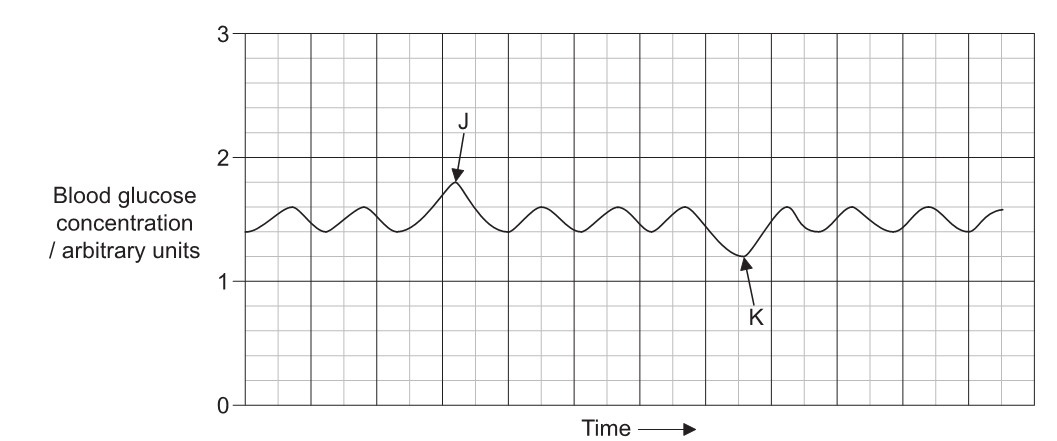
What hormones were secreted at J and K?
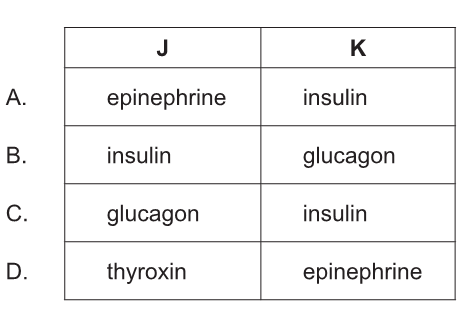
▶️Answer/Explanation
Markscheme
B
Based on the graph, the hormones that were secreted at J and K are insulin and glucagon respectively.
At J, the blood glucose concentration is high, so the pancreas secretes insulin to decrease the blood glucose concentration by promoting the uptake of glucose by the cells.
At K, the blood glucose concentration is low, so the pancreas secretes glucagon to increase the blood glucose concentration by promoting the conversion of glycogen to glucose in the liver.
The graph shows the changes in blood glucose concentration of an untreated patient with type I diabetes and a non-diabetic person after a meal.
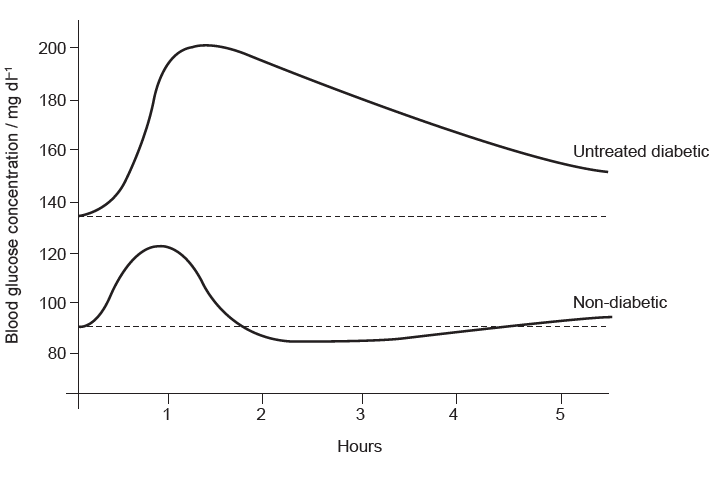
Which statement correctly describes the events in this untreated diabetic patient immediately after a meal was eaten?
A. Alpha cells of the pancreas secrete too little glucagon.
B. Beta cells of the pancreas secrete too little glucagon.
C. Alpha cells of the pancreas secrete too little insulin.
D. Beta cells of the pancreas secrete too little insulin.
▶️Answer/Explanation
Markscheme
D
The statement “alpha cells of the pancreas secrete too little insulin”, correctly describes the events in this untreated diabetic patient immediately after a meal was eaten is that beta cells of the pancreas secrete too little insulin. Therefore, the correct answer is D.
Which describes the secretion of hormones in the pancreas in response to low levels of glucose in the blood?
A. Secretion of glucagon from α cells
B. Secretion of glucagon from β cells
C. Secretion of insulin from α cells
D. Secretion of insulin from β cells
▶️Answer/Explanation
Markscheme
A
The secretion of hormones in the pancreas in response to low levels of glucose in the blood is the secretion of glucagon from α cells. This is option A. Glucagon is a hormone that is produced by α cells in the pancreas and is released in response to low blood glucose levels. Glucagon helps to raise blood glucose levels by stimulating the liver to release glucose into the bloodstream. Conversely, insulin is produced by β cells in the pancreas and is released in response to high blood glucose levels. Insulin helps to lower blood glucose levels by promoting the uptake of glucose by cells in the body.
Which hormone shows the greatest fall in blood concentration just before menstruation?
A. FSH (follicle stimulating hormone)
B. LH (luteinizing hormone)
C. Progesterone
D. Estrogen
▶️Answer/Explanation
Markscheme
C
The hormone that shows the greatest fall in blood concentration just before menstruation is progesterone. This is option C. Progesterone is a hormone that is produced by the ovaries and is involved in preparing the uterus for pregnancy. In the menstrual cycle, progesterone levels rise after ovulation to help prepare the uterus for implantation of a fertilized egg. If pregnancy does not occur, progesterone levels fall, triggering the shedding of the uterine lining and the onset of menstruation. Estrogen and LH are also involved in the menstrual cycle, but their levels do not show the same significant drop just before menstruation as progesterone. FSH is involved in the growth and development of ovarian follicles, but it does not show a significant change in concentration just before menstruation.
What happens when human body temperature rises during exercise?
A. The arterioles move closer to the skin.
B. The hypothalamus decreases cell respiration.
C. The skin capillaries close up.
D. The water from sweat evaporates to cool the body.
▶️/Explanation
Markscheme
D
When human body temperature rises during exercise, the water from sweat evaporates to cool the body. This is option D. As the body temperature rises, the sweat glands produce sweat, which evaporates from the skin, taking heat with it and cooling the body. This is known as evaporative cooling. The hypothalamus in the brain plays a key role in regulating body temperature by triggering sweating and other responses to cool the body. The arterioles move closer to the skin and the skin capillaries dilate to allow more blood flow to the skin, which helps to dissipate heat. The hypothalamus does not decrease cell respiration during exercise.
The diagram below represents the homeostatic control of body temperature. What does the part labelled X represent?

A. Heart
B. Kidney
C. Pituitary
D. Hypothalamus
▶️Answer/Explanation
Markscheme
D
The part labelled X represents the Hypothalamus. The hypothalamus is a part of the brain that is responsible for regulating body temperature, among other things. It acts as the body’s thermostat, monitoring the temperature of the blood and responding to changes by triggering sweating or shivering to adjust the body’s temperature. The hypothalamus also controls hunger, thirst, and other basic functions.
What are the structures labelled I and II on the diagram of the male reproductive system?
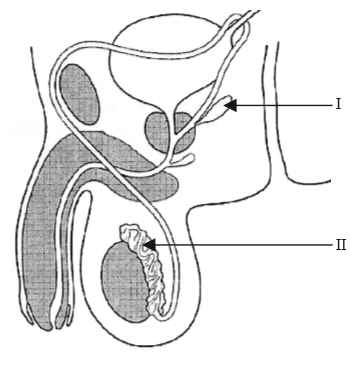
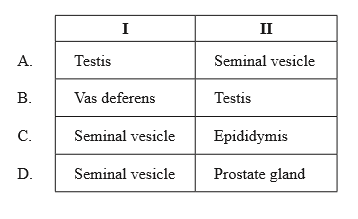
▶️Answer/Explanation
Markscheme
C
I) The seminal vesicle is a gland located in the male reproductive system that produces a fluid that is a component of semen. The seminal vesicle fluid contains a variety of substances, including fructose, prostaglandins, and enzymes, that help to nourish and protect the sperm as they travel through the female reproductive system. The seminal vesicles are located behind the bladder and are connected to the vas deferens, which carries sperm from the testes to the urethra.
II) The epididymis is a coiled tube located behind each testicle in the male reproductive system. It is responsible for storing and transporting sperm from the testes to the vas deferens, which carries sperm to the urethra. The epididymis also plays a role in the maturation and development of sperm, as well as in the absorption of damaged or defective sperm. The epididymis is composed of three main parts: the head, the body, and the tail.
Question
Melatonin controls circadian rhythms and is involved in the sleep-wake cycle. The pineal gland, which secretes melatonin, is inhibited by light. The graph shows a normal cycle where bedtime is
around 10pm.
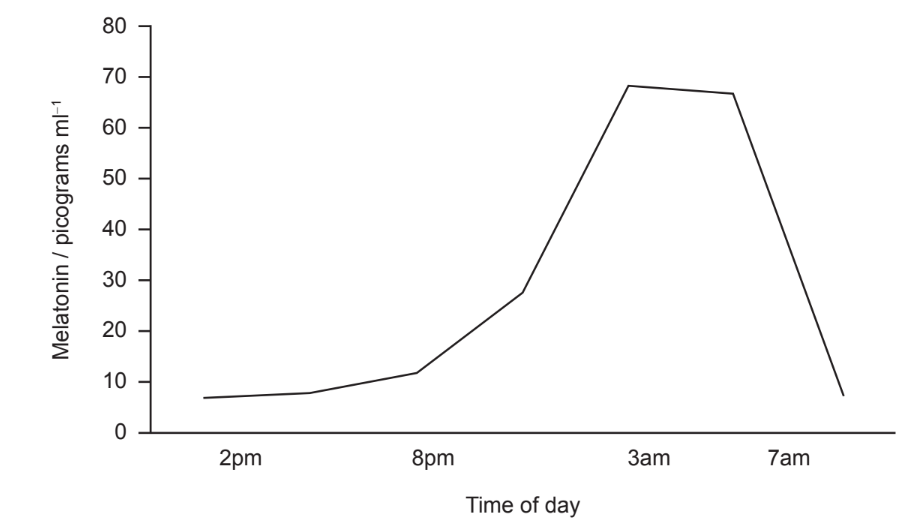
Using data from the graph, what might be the effect(s) of screen light from a laptop, tablet or phone at bedtime?
I. Delay in melatonin production
II. Lower peak concentration of melatonin
III. Peak of melatonin earlier in the evening
A. I only
B. III only
C. II and III only
D. I, II and III
▶️Answer/Explanation
Ans:B
Based on the information provided, the effect(s) of screen light from a laptop, tablet, or phone at bedtime would be a delay in melatonin production (I) and a lower peak concentration of melatonin (II). Therefore, the answer is C. II and III only.
